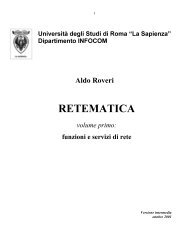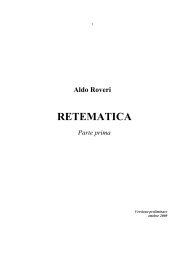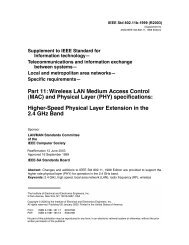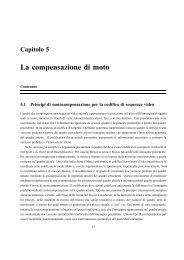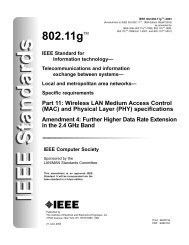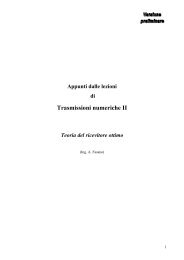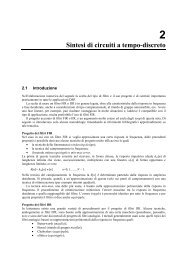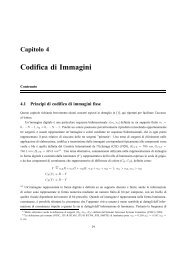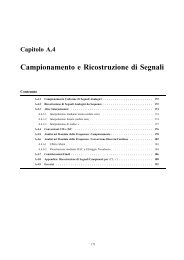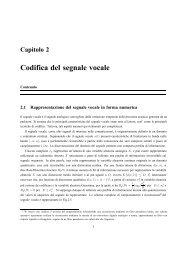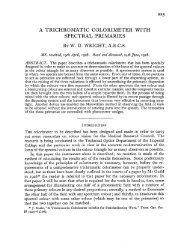Lo Standard JPEG per la Compressione di Immagini Fisse - InfoCom
Lo Standard JPEG per la Compressione di Immagini Fisse - InfoCom
Lo Standard JPEG per la Compressione di Immagini Fisse - InfoCom
You also want an ePaper? Increase the reach of your titles
YUMPU automatically turns print PDFs into web optimized ePapers that Google loves.
58 CAPITOLO 3. LO STANDARD <strong>JPEG</strong> PER LA COMPRESSIONE DI IMMAGINI FISSE<br />
3.4 Modalità Gerarchica<br />
Tale modalità rappresenta una alternativa al<strong>la</strong> realizzazione del<strong>la</strong> modalità progressiva, e si basa sul<strong>la</strong> co<strong>di</strong>fica <strong>di</strong> una<br />
immagine come successione <strong>di</strong> immagini a risoluzione via via crescente.<br />
M:1 =<br />
2 / M<br />
2<br />
2 / M<br />
b g F H G I K J F H G I K J<br />
j j<br />
<br />
1 2 1mod 2<br />
2mod<br />
2<br />
He , e rect<br />
rect<br />
2M<br />
2M<br />
Figura 3.12: Sottocampionamento bi<strong>di</strong>mensionale.<br />
Il termine risoluzione si riferisce al contenuto <strong>di</strong> frequenze spaziali dell’immagine. L’o<strong>per</strong>azione <strong>di</strong> sottocampionamento,<br />
ottenuta <strong>per</strong> filtraggio e decimazione3.3 come illustrato in Fig.3.12 definisce il contenuto <strong>di</strong> frequenze spaziali<br />
dell’immagine da co<strong>di</strong>ficare. Il filtraggio è necessario <strong>per</strong> evitare l’introduzione <strong>di</strong> <strong>di</strong>storsione da aliasing nel<strong>la</strong><br />
successiva o<strong>per</strong>azione <strong>di</strong> decimazione.<br />
1:P =<br />
PB<br />
1<br />
2 / P<br />
MB<br />
b g F H G I K J F H G I K J<br />
j j<br />
<br />
1 2 2 1mod 2<br />
2mod<br />
2<br />
He , e P rect<br />
rect<br />
2P<br />
2P<br />
Figura 3.13: Interpo<strong>la</strong>zione bi<strong>di</strong>mensionale.<br />
L’o<strong>per</strong>azione <strong>di</strong> interpo<strong>la</strong>zione, ottenuta <strong>per</strong> espansione3.4 e filtraggio come illustrato in Fig.3.13, ripristina soltanto<br />
le corrette <strong>di</strong>mensioni dell’immagine, che risulta comunque a banda limitata (non pienamente risoluta). Il guadagno<br />
del filtro recu<strong>per</strong>a lo sca<strong>la</strong>mento introdotto da precedenti o<strong>per</strong>azioni <strong>di</strong> sottocampionamento.<br />
3.3 L’o<strong>per</strong>azione <strong>di</strong> decimazione <strong>di</strong> un fattore M in entrambe le <strong>di</strong>mensioni è definita come segue:<br />
xd[n1,n2] def<br />
= x[n1 · M, n2 · M]<br />
3.4L’o<strong>per</strong>azione <strong>di</strong> espansione <strong>di</strong> un fattore P in entrambe le <strong>di</strong>mensioni è definita come segue:<br />
xe[n1,n2] def<br />
⎧<br />
⎨x[n1/P,<br />
n2/P ] <strong>per</strong> n1,n2 =0 modP (n1 e n2 multipli <strong>di</strong> P )<br />
=<br />
⎩0<br />
<strong>per</strong> n1,n2 = 0 modP (n1 e n2 non multipli <strong>di</strong> P )<br />
2<br />
2 / P<br />
1



